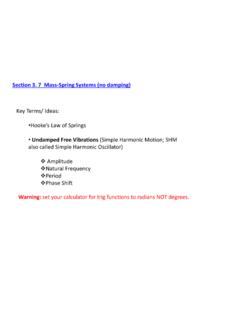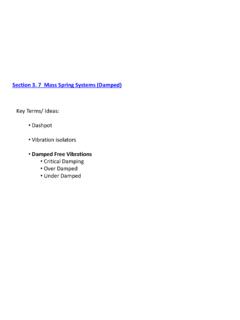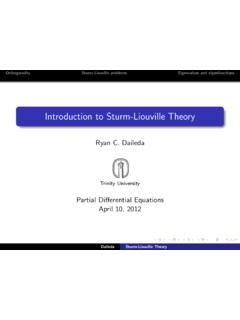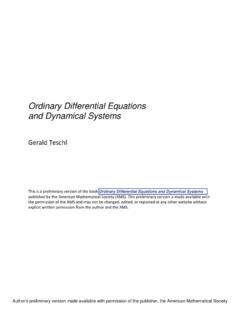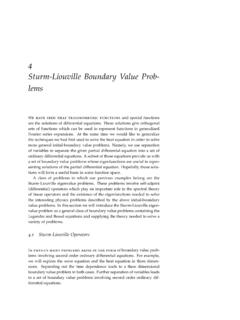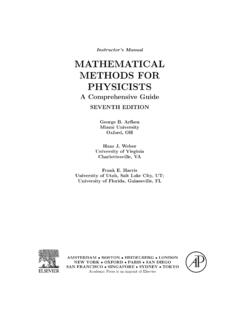Transcription of Mathematical Methods for Physics - Temple University
1 Mathematical Methods for PhysicsPeter S. RiseboroughJune 18, 2018 Contents1 Mathematics and Physics52 Vector Vectors .. Scalar Products .. The Gradient .. The Divergence .. The Curl .. Successive Applications of .. Gauss s Theorem .. Stokes s Theorem .. Non-Orthogonal Coordinate Systems .. Coordinate Systems .. Polar Coordinates .. Gradient .. Divergence .. Curl .. Vector Differential Operators in Curvilin-ear Coordinates .. 233 Partial Differential Linear First-Order Partial Differential Equations .. Classification of Partial Differential Equations .. Boundary Conditions .. Separation of Variables.
2 484 Ordinary Differential Linear Ordinary Differential Equations .. Points .. The Frobenius Method .. Points .. Singularities .. Linear Dependence .. Independent Solutions .. s Theorem .. Solutions .. 915 St urm Liouville Degenerate Eigenfunctions .. The Inner Product .. Orthogonality of Eigenfunctions .. Orthogonality and Linear Independence .. Gram-Schmidt Orthogonalization .. Completeness of Eigenfunctions .. 1066 Fourier Fourier Transform of Derivatives .. Convolution Theorem .. Parseval s Relation .. 1177 Fourier Gibbs Phenomenon .. 1238 Bessel Generating Function Expansion .. Expansion.
3 Relations .. s Equation .. Representation .. Theorem .. Series .. Neumann Functions .. Spherical Bessel Functions .. Relations .. Relations .. Neumann Functions .. 1599 Legendre Function Expansion .. Expansion .. Relations .. s Equation .. Expansions .. Associated Legendre Functions .. Associated Legendre Equation .. Function Expansion .. Relations .. Spherical Harmonics .. in Spherical Harmonics .. Theorem .. 19310 Hermite Recursion Relations .. Hermite s Differential Equation .. Orthogonality .. 19811 Laguerre Recursion Relations .. Laguerre s Differential Equation .. Associated Laguerre Polynomials.
4 Generating Function Expansion .. 20212 Inhomogeneous Inhomogeneous Differential Equations .. Eigenfunction Expansion .. Piece-wise Continuous Solution .. Inhomogeneous Partial Differential Equations .. The Symmetry of the Green s Function.. Eigenfunction Expansion .. 23013 Complex Contour Integration .. Cauchy s Integral Theorem .. Cauchy s Integral Formula .. Derivatives .. Morera s Theorem.. 25814 Complex Taylor Series .. Analytic Continuation .. Laurent Series .. Branch Points and Branch Cuts .. Singularities .. 271315 Calculus of Residue Theorem .. Jordan s Lemma .. Cauchy s Principal Value .. Contour Integration .. The Poisson Summation Formula.
5 Kramers-Kronig Relations .. Integral Representations .. 30041 Mathematics and PhysicsPhysics is a science which relates measurements and measurable quantities to afew fundamental laws or is a quantitative science, and as such the relationships are laws or principles of Physics must be able to be formulated as physical laws are to be fundamental, they must be few in number and mustbe able to be stated in ways which are independent of any arbitrary particular, a physical law must be able to be stated in a way which is in-dependent of the choice of reference frame in which the measurements are laws or principles of Physics are usually formulated as differential equa-tions, as they relate changes. The laws must be invariant under the choice ofcoordinate system.
6 Therefore, one needs to express the differentials in wayswhich are invariant under coordinate transformations, or at least have definiteand easily calculable transformation is useful to start by formulating the laws in fixed Cartesian coordinatesystems, and then consider invariance under:-(i) Translations(ii) Rotations(iii) Boosts to Inertial Reference Frames(iv) Boosts to Accelerating Reference FramesQuantities such as scalars and vectors have definite transformation proper-ties under translations and are invariant under transform in the same way as a displacement under Vector VectorsConsider the displacement vector, in a Cartesian coordinate system it can beexpressed as r= exx+ eyy+ ezz(1)where ex, eyand ez, are three orthogonal unit vectors, with fixed components of the displacement are (x,y,z).
7 In a different coordinate system, one in which is (passively) rotated throughan angle with respect to the original coordinate system, the displacement vec-tor is unchanged. However, the components (x ,y ,z ) defined with respect tothe new unit vectors e x, e yand e z, are specific example is given by the rotation about thez-axis r= e xx + e yy + e zz (2)The new components are given in terms of the old components by x y z = cos sin 0 sin cos 0001 xyz (3)Hence, r= e x(xcos +ysin ) + e y(ycos xsin ) + e zz (4)The inverse transformation is given by the substitution , r= ex(x cos y sin ) + ey(y cos +x sin ) + ezz(5)Any arbitrary vector Acan be expressed as A= exAx+ eyAy+ ezAz(6)where ex, eyand ez, are three orthogonal unit vectors, with fixed components of the displacement are (Ax,Ay,Az).
8 The arbitrary vectortransforms under rotations exactly the same way as the displacement A= e x(Axcos +Aysin ) + e y(Aycos Axsin ) + e zA z(7) Scalar ProductsAlthough vectors are transformed under rotations, there are quantities asso-ciated with the vectors that are invariant under rotations. These invariantquantities include:-(i) Lengths of vectors.(ii) Angles between invariant properties can be formulated in terms of the invariance of ascalar scalar product of two vectors is defined as A . B=AxBx+AyBy+AzBz(8)The scalar product transforms exactly the same way as a scalar under rotations,and is thus a scalar or invariant quantity. A . B=AxBx+AyBy+AzBz=A xB x+A yB y+A zB z(9) The GradientThe gradient represents the rate of change of a scalar quantity ( r).
9 The gra-dient is a vector quantity which shows the direction and the maximum rate ofchange of the scalar quantity. The gradient can be introduced through consid-eration of a Taylor expansion ( r+ a)= ( r) +ax x+ay y+az z+..= ( r) + a . ( r) +..(10)The change in the scalar qunatity is written in the form of a scalar product ofthe vector displacement agiven by a= exax+ eyay+ ezaz(11)with another quantity defined by = ex x+ ey y+ ez z(12)The latter quantity is a vector quantity, as follows from the scalar quantities ( r) and ( r+ a) being invariant. Thus, the dot product in the Taylor ex-pansion must behave like a scalar. This is the case if is a vector, since thescalar product of the two vectors is a gradient operator is defined as = ex x+ ey y+ ez z(13)The gradient operator is an abstraction, and only makes good sense when theoperator acts on a differentiable gradient specifies the rate of change of a scalar field, and the directionof the gradient is in the direction of largest example of the gradient that occurs in physical applications is the rela-tionship between electric field and the scalar potential E= (14)in electro-statics.
10 This has the physical meaning that a particle will move (ac-celerate) from regions of high potential to low potential,. The particle alwaysaccelerates in the direction of the maximum decrease in a point charge of magnitudeqthe potential is given by =qr(15)and the electric field is given by E= +q rr3(16) The DivergenceThe gradient operator, since it looks like a vector, could possibly be used in ascalar product with a differentiable vector field. This can be used to define thedivergence of a vector as the scalar product . A(17)The divergence is a scalar Cartesian coordinates, the divergence is evaluated from the scalar productas . A= Ax x+ Ay y+ Az z(18)8 Consider a vector quantity Aof the form A= r f(r)(19)which is spherically symmetric and directed radially from the origin.

